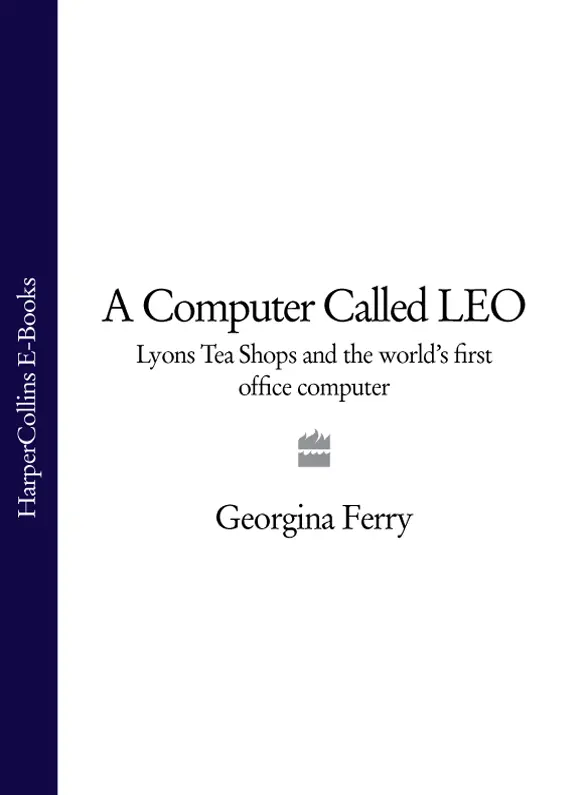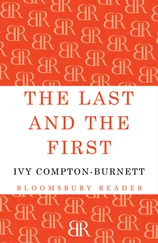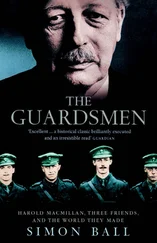
Lyons Teashops and the World’sFirst Office Computer

Cover
Title Page A Computer Called LEO Lyons Teashops and the World’sFirst Office Computer
Preface
1 A Mission to Manage
2 The Electronic Brain
3 Made in Britain
4 A Computer for Lyons
5 LEO goes to work
6 In Business
7 Leo’s Last Roar
Epilogue
Sources
Index
P.S. Ideas, Interviews & Features …
About the Author
Profile of Georgina Ferry
Snapshot
Top Ten Favourite Books
About the Book
A Critical Eye
Imagining the Future
Read On
Have You Read?
If You Loved This You’ll Like …
Find Out More
Acknowledgements
About the Author
Praise
Copyright
About the Publisher
MEET THE £150,000 ROBOT THAT KNOWS ALL THE ANSWERS.
Puzzled? LEO the Brain Will Do Your Thinking For You.
Robots have begun taking over work which is too complicated or too laborious for human beings. In cold print this may seem fanciful. But now one is confronted by LEO, Britain’s new electronic brain … He is the only one of his kind on commercial work in the world.
Evening News , 16 February 1954
What is there in a name? Plenty if it is LEO, for it is a name coined at the dawn of computer technology, that has carried with it a long list of first achievements. For that reason alone it merits perpetuation.
Engineering , 5 March 1965
To some, it was a supreme irrelevance, a quixotic venture into the unknown by a respectable family business that ought to have known better. To others, it was an enterprise of boldness and vision, whose ultimate failure resulted from the conservatism and short-sightedness of others, and whose story contains lessons that succeeding generations would do well to learn.
LEO was a computer. It burst into the British public consciousness through a snowstorm of popular articles in February 1954, although its genesis lay some years earlier. It was not the first computer in the world, by any of a number of possible definitions. As a piece of electronic engineering it was not fundamentally original. LEO and its creators deserve their place in history not because of what it was but because of what it did. For LEO was the first computer in the world to be harnessed to the task of managing a business. That business was J. Lyons & Co., renowned the length and breadth of the land for its fine tea and cakes, available in grocers’ shops everywhere but savoured especially in the Lyons teashops, a chain of more than two hundred high street cafés.
LEO was designed and built by Lyons’s own engineers, and its first programs were written by Lyons managers before the computer programmer existed as a job description. At the time, the few who knew anything about computers thought of them as tools for scientists and mathematicians. LEO was a novelty in that its circuits hummed not with non-linear equations but with the hours worked and rates of pay for the bakers who produced, among other things, 36 miles of Swiss roll per day. Rather than calculating missile trajectories (though it could do that, too), LEO grappled with the task of restocking each teashop every day with no more and no less than it needed to keep its customers supplied with bread rolls, boiled beef and ice cream. It even turned its attention to ensuring that Lyons continued to produce the perfect blends of tea on which so much of the company’s reputation rested.
Fifty years later it is hard to imagine a time when the computerisation of such activities was remarkable or even revolutionary. Today we use computers not only for all forms of record-keeping and financial management but to go shopping, to teach children, to fly aeroplanes (and to write books). They have become an extension of more or less every human cognitive capacity, and invaded every area of human activity. Off-the-shelf software packages have removed the need to understand how computers work or to speak their language – instead it is we who are programmed to point and click. But to reach this point we had to start somewhere, and LEO was in at the beginning.
LEO’s development brought about the convergence of two histories that until that point had been quite separate: the history of computers, and the history of office management and office machines. In this it anticipated by at least five years IBM, a giant of the office machines business in the first half of the twentieth century but a relative latecomer to commercial computers. LEO’s creators were acutely conscious of their pioneering role, and were not slow to exploit the opportunities of their position. Soon after LEO’s first public debut, with several applications running successfully on a single machine and interest building from outside the company, Lyons set up a subsidiary called Leo Computers Ltd, with the intention of manufacturing computers for sale to other businesses.
A background in catering is not normally seen as an obvious qualification for high-tech start-up companies, and Leo’s later history showed that many potential customers and others found this hard to swallow. They made the mistake of judging Lyons by its best-known products: cake-making was seen as a light and fluffy enterprise, a far cry from the sparks and sinews of electronic engineering.
Nevertheless, the advantage gained simply by being first in the field meant that for a brief period in the late 1950s Leo Computers Ltd was one of the leading computer manufacturers and computing consultancies in Britain, if not the world. That shining moment of glory was achieved by a small group of individuals whose vision of what computers could achieve – and how to manage them so that they fulfilled their potential – showed a creative imagination unmatched in their time by those running any other business. Their story has now been all but forgotten, except by those who participated directly and the slightly wider circle of computer history buffs. As we move into a world in which it seems there is no business that is not e-business, it seems timely to look again at how it was that technology, commerce and management converged in a British catering firm to produce the world’s first business computer.
The clatter of machinery was relentless. Light fell through the high windows on row after row of workers, bent to their identical tasks; but this was no factory. This was the Checking Department of J. Lyons & Co. at Cadby Hall in West London, part of the vast clerical infrastructure that underpinned the operation of Britain’s largest food empire in its mid-1930s heyday. Seated at their desks in ruler-straight rows, the clerks tapped away at their Burroughs mechanical calculators, separated from one another by partitions erected to reduce distraction. The adding machines, solid constructions of steel and varnished wood, had up to a dozen columns of numbered keys to input the figures, and a crank on the side to sum the totals. Like a cash register, they printed out a record of the calculation on a roll of paper.
The three hundred clerks in the department, most of them girls not long out of school, had but a single job to do: to add up the totals on the waitresses’ bills from the two hundred and fifty-odd high street teashops run by Lyons, and to check them against the cash takings banked by the shops. A squad of office boys kept them supplied with sets of bills, received from the teashops that morning in locked leather bags and sorted into numerical and alphabetical order by the office juniors. The senior clerks and managers, invariably male, stalked the aisles between the desks in their sombre suits, ensuring that every fashionably waved head was bent to its task; it would be their duty to follow up any discrepancies revealed as the streams of numbers gradually unrolled.
Читать дальше














